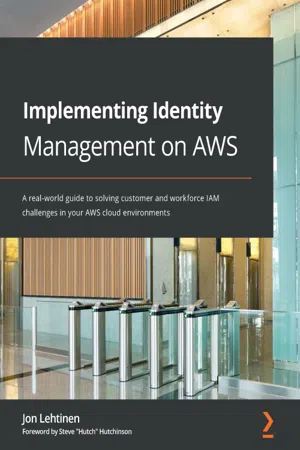
- 504 pages
- English
- ePUB (mobile friendly)
- Available on iOS & Android
Implementing Identity Management on AWS
About this book
Understand the IAM toolsets, capabilities, and paradigms of the AWS platform and learn how to apply practical identity use cases to AWS at the administrative and application levelKey Features• Learn administrative lifecycle management and authorization• Extend workforce identity to AWS for applications deployed to Amazon Web Services (AWS)• Understand how to use native AWS IAM capabilities with apps deployed to AWSBook DescriptionAWS identity management offers a powerful yet complex array of native capabilities and connections to existing enterprise identity systems for administrative and application identity use cases. This book breaks down the complexities involved by adopting a use-case-driven approach that helps identity and cloud engineers understand how to use the right mix of native AWS capabilities and external IAM components to achieve the business and security outcomes they want. You will begin by learning about the IAM toolsets and paradigms within AWS. This will allow you to determine how to best leverage them for administrative control, extending workforce identities to the cloud, and using IAM toolsets and paradigms on an app deployed on AWS. Next, the book demonstrates how to extend your on-premise administrative IAM capabilities to the AWS backplane, as well as how to make your workforce identities available for AWS-deployed applications. In the concluding chapters, you'll learn how to use the native identity services with applications deployed on AWS. By the end of this IAM Amazon Web Services book, you will be able to build enterprise-class solutions for administrative and application identity using AWS IAM tools and external identity systems.What you will learn• Understand AWS IAM concepts, terminology, and services• Explore AWS IAM, Amazon Cognito, AWS SSO, and AWS Directory Service to solve customer and workforce identity problems• Apply the concepts you learn about to solve business, process, and compliance challenges when expanding into AWS• Navigate the AWS CLI to unlock the programmatic administration of AWS• Explore how AWS IAM, its policy objects, and notational language can be applied to solve security and access management use cases• Relate concepts easily to your own environment through IAM patterns and best practicesWho this book is forIdentity engineers and administrators, cloud administrators, security architects, or anyone who wants to explore and manage IAM solutions in AWS will find this book useful. Basic knowledge of AWS cloud infrastructure and services is required to understand the concepts covered in the book more effectively.
Frequently asked questions
- Essential is ideal for learners and professionals who enjoy exploring a wide range of subjects. Access the Essential Library with 800,000+ trusted titles and best-sellers across business, personal growth, and the humanities. Includes unlimited reading time and Standard Read Aloud voice.
- Complete: Perfect for advanced learners and researchers needing full, unrestricted access. Unlock 1.4M+ books across hundreds of subjects, including academic and specialized titles. The Complete Plan also includes advanced features like Premium Read Aloud and Research Assistant.
Please note we cannot support devices running on iOS 13 and Android 7 or earlier. Learn more about using the app.
Information
Section 1: IAM and AWS – Critical Concepts, Definitions, and Tools
- Chapter 1, An Introduction to IAM and AWS IAM Concepts
- Chapter 2, An Introduction to the AWS CLI
- Chapter 3, IAM User Management
- Chapter 4, Access Management, Policies, and Permissions
- Chapter 5, Introducing Amazon Cognito
- Chapter 6, Introduction to AWS Organizations and AWS Single Sign-On
- Chapter 7, Other AWS Identity Services
Chapter 1: An Introduction to IAM and AWS IAM Concepts
- Understanding IAM
- Exploring AWS IAM
- Putting it all together
Technical requirements
- A web browser
- An AWS account
Understanding IAM
- Keeping accounts up to date
- Keeping downstream consumers of those accounts synchronized with the authoritative sources that define the account
- Provisioning and deprovisioning accounts entirely from various data stores
IAM applied to real-world use cases

Table of contents
- Implementing Identity Management on AWS
- Foreword
- Preface
- Section 1: IAM and AWS – Critical Concepts, Definitions, and Tools
- Chapter 1: An Introduction to IAM and AWS IAM Concepts
- Chapter 2: An Introduction to the AWS CLI
- Chapter 3: IAM User Management
- Chapter 4: Access Management, Policies, and Permissions
- Chapter 5: Introducing Amazon Cognito
- Chapter 6: Introduction to AWS Organizations and AWS Single Sign-On
- Chapter 7: Other AWS Identity Services
- Section 2: Implementing IAM on AWS for Administrative Use Cases
- Chapter 8: An Ounce of Prevention – Planning Your Administrative Model
- Chapter 9: Bringing Your Admins into the AWS Administrative Backplane
- Chapter 10: Administrative Single Sign-On to the AWS Backplane
- Section 3: Implementing IAM on AWS for Application Use Cases
- Chapter 11: Bringing Your Users into AWS
- Chapter 12: AWS-Hosted Application Single Sign-On Using an Existing Identity Provider
- Other Books You May Enjoy